Saturday February 23 was a mix of sun and cloud. It was cool but still managed to get to 18C. When the sun was out it felt warm, but when the clouds rolled in it cooled down. The rain has held off so far.
We took the bus out to the Christchurch Saturday Market at Riccarton Bush, a lovely park in the suburb of Riccarton about a 30 minute bus ride from our apartment. As we paid the $4 each fare on the bus, the driver told us to hold on to the ticket as it was good for two hours. This was great as we were able to get back on the same ticket. We find it strange to buy tickets on the bus, but that is the NZ way. Tickets are less expensive if one has a Metro pass, but it wasn't worth it for the four days we are in Christchurch as we are walking most days.
The Market started in 2003 and has grown from 10 stalls to its present 80 stalls.
 |
| Farmers' Market banner |
 |
| Busy market that has grown to about 80 stalls |
 |
| Bellbird breads and pastries- Alain had a croissant |
 |
| Olives |
 |
| The Saturday crowd |
 |
| A stream through the park beside the market |
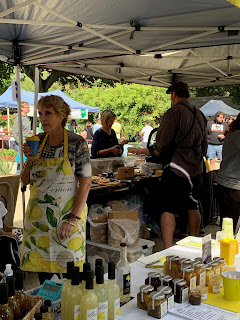 |
| All things lemon |
 |
| Mama Bear granola |
 |
| Bacon Bros. Burgers have been at all the Farmer's Markets we have been to in NZ |
 |
| Canterbury Kombucha |
 |
| Posh Porridge and Posh Pancakes |
 |
| Fabulous Cheese stall |
 |
| Cheeses on tap today-- we bought our favourite sheep cheese from outside Nelson |
 |
| View leaving Riccarton Bush |
 |
| Very nice houses near the park |
We took the bus back to our apartment and then walked into town. We stopped for coffee at C4 Coffee Co., our new favourite coffee of the trip so far. Alain bought some "Villain" beans and talked to one of the roasters. They also charge a lot less for their espresso at their headquarters than the usual charge in NZ--- $2.50 instead of $4.00 and their flat white was $3.50 instead of $4.50. The place was busy on Saturday and they had already sold out of their sandwiches.
 |
| Alain buying beans |
We passed another beautiful tile work. This one was entitled Maumahara- Remembering our Fallen in Battle.
We walked back to the Earthquake Memorial Wall as we had missed the pounamu (greenstone) that was placed at the entrance at one side of the wall.
 |
| The pounamu at the entrance to the Memorial Wall |
 |
| Paying respects |
We then went to the Christchurch Art Gallery, where we spent a wonderful two hours exploring their permanent and temporary exhibits. It is a fabulous gallery (one of the best we have visited). It closed at 5:00 p.m., and we will return tomorrow to finish one of the exhibits.
 |
| Poster for Head [Case] which just opened (wonderful ceramics) |
 |
| Gordon Walters New Vision-- our favourite exhibit |
The foyer of the gallery was wonderful with some great pieces on the wall. I really was taken with the exhibit of coloured chairs and fluorescent tubes that hung from the ceiling. It was a wonderful piece by Bill Culbert (b. 1935) New Zealand/England/France called
Bebop 2013. He had made
Bebop for a corridor in an old church in Venice when he represented NZ at the Venice Biennale in 2013. It was purchased by the Christchurch Art Gallery in 2014.
 |
| Foyer of the gallery |
 |
| Looking up at Bebop |
 |
| Bebop |
We were told at the entrance, that the room on the main floor with the exhibit that had just opened was crowded and that we might want to start on the second floor. We started with an exhibit entitled
Hidden Light: Early Canterbury and West Coast Photography. Very interesting photographs from early days in this region.
 |
| Grand & Dunlop cartes-de-visite William Grand (1836-1909) England/New Zealand |
 |
| Reproduction of works by Alfred C. Barker (England/New Zealand 1819-1873) |
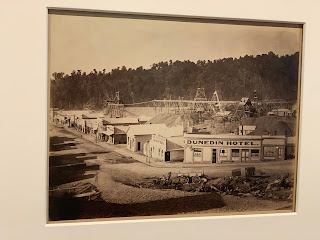 |
| Dunedin Hotel 1870-71 Thomas Pringle (Scotland/New Zealand 1827-1873) |
 |
| Men looking through a frame 1873-79 Thomas Edward Price Wales/Australia/New Zealand 1844-1928 |
 |
| Unidentified woman 1890s William Edwin Sorrell England/New Zealand, 1856-1933 |
We then went into a room entitled
New Dawn Fades: Historical European Art. It featured a selection of the Gallery's most treasured historical artworks. There were some beautiful paintings by Petrus van Der Velds (Netherlands/New Zealand, 1837-1913), a Dutch painter who moved to Christchurch in 1890.
 |
| Burial in the winter on the island of Market [The Dutch Funeral] 1875 |
 |
| Marken Funeral Barge 1874 |
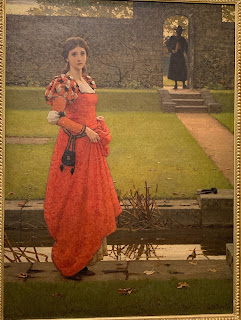 |
| In the Wizard's Garden c. 1904 George Leslie (England, 1835-1921) |
 |
| Factory at Widnes 1965 L.S. Lowry England, 1887-1976 |
The next gallery featured New Zealand artists.
 |
Murals (Waikari) 1951 Bill Sutton (New Zealand, 1919-2000).
Sutton spent many years travelling throughout the Canterbury landscape |
 |
| Takarangi 2007 Shane Cotton (New Zealand, b. 1964). Cotton is one of Aeotearoa New Zealsn's most important painters and contemporary Māori artists. Manu (birds) are signifiant in the Māori world. |
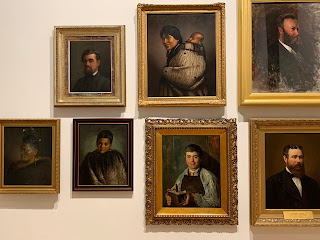 |
| Faces from the past |
We liked the work of Rita Angus (1908-1970). Her use of colour was amazing.
 |
| Mount Maud 1938 |
 |
| Gasworks 1933 |
 |
| Cass 1936 |
There were other wonderful paintings by New Zealand artists.
 |
| Landscape Overlooking Kaitawa, Waikaremoana 1948 - Doris Lusk (New Zealand 1916-1990) |
 |
| Road through Arrowtown 1942 Evelyn Page (New Zealand, 1899-1988) |
Colin McCahon (1919-1987) has been one of our favourite New Zealand artists we have seen in Museums and Galleries on our trip. He lived and painted in Christchurch between 1948 and 1953.
 |
| Canterbury Plains 1951 |
 |
| As there is a constant flow of light we are born into the pure land 1965 |
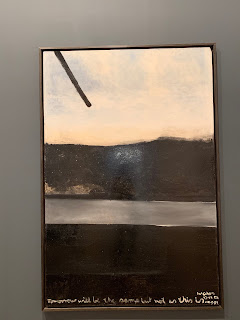 |
| Tomorrow will be the same but not as this is 1958-59 |
 |
| Summer Storm near Wanake- Doris Lusk (1916-1990) |
There was a small room with an exhibit entitled:
Trusttum: Just a Glimpse. It featured the work of Philip Trusttum, who is one of Canterbury's most respected painters. (Christchurch is in Canterbury District in NZ). He is known for his high-energy paintings inspired by everyday life. Imagery such as his grandchildren's toys, road cones-a common sight since the 2010/11earthquakes are painted on a grand scale. He recently gave fifteen large paintings to the Christchurch Art Gallery.
Just a Glimpse presents a selection of these.
 |
| The Artist (b. 1940 New Zealand) |
 |
| Waimate Flag 1987 |
 |
| Schooling 1987/1997 |
 |
| Amer 2006 |
 |
| Here We Go Again 2015 |
The next exhibit we went to was entitled:
Eileen Mayo: Nature, Art and Poetry. Dame Eileen Mayo DBE, was an English born artist and designer who worked in England, Australia and New Zealand in almost every available medium- drawings, woodcuts, lithographs, tapestry and silk screening. She was born in 1906 in Norwich, England and died in 1994 in Christchurch NZ. She settled in Christchurch in 1965 following a notable career in England. Mayo's intense interest in nature spanned her career of more than six decades. Plant, animal and sea life were recurring themes in her work. She was a very skilful artist and designer and had an ability to master almost any medium she chose to take up. We had never heard of her before- but really enjoyed the exhibit.
Mayo first began working with wood engravings in the mid-1920s while studying at the Central School of Arts and Crafts in London. Very beautiful works
 |
| New Year 1949 |
 |
| Skaters 1925 |
In 1930, Mayo began producing linocuts, a relatively new medium at that time.
 |
| Turkish Bath 1930- Linocut |
 |
| Ice Cream Cart 1932 Linocut |
 |
| Wounded Bird 1965 Linocut |
 |
Rare and Endangered Birds of NZ- paintings by Eileen Mayo, published by W. Gregg and Co. Dunedin 1976
Gouache and coloured pencil on paper |
 |
| A Garden Enclosed 1980 (in Christchurch's Botanic Garden) |
Mayo also loved typography. Apparently, her handwriting was exquisite and she enjoyed the form of letters and used them in several of her prints.
 |
| Alphabets 1982 |
 |
| Young Sunflower 1979- Linocut |
We then went to the main floor where there were a number of exhibits by contemporary artists.
First was the amazing
Head[Case] featuring the work of Julia Morison, which had just opened.

This project was four years in the making. More than 100 ceramic heads were displaced within seven small hexagonal rooms. Based on a wig-maker's block, each genderless head is made distinctly different from the next. Morison is best known as a painter, but she was inspired to begin working in ceramics by reading Edmund de Waal's
The Hare with Amber Eyes, which tells the story of a netsuke set that has been passed down through several generations (one of my favourite books). She began with drawings, but working with the clay directly produced unexpected results. It was an incredibly innovative exhibit. The ceramic heads and the whole concept was so well done.
 |
| The heads displayed at a number of different levels |
 |
| These looked like they were talking to each other |
 |
| Lots of people on opening day of this exhibit |
 |
| Very creative |
 |
| More chat |
 |
| A bit eerie |
 |
| With hair... |
 |
| Another pair |
We then went to a fabulous exhibit entitled
Gordon Walters: New Vision. Walters (1919-1995) was one of New Zealand's most significant modern artists. For more than five decades, he explored the abstract potential of a limited range of forms. He described his art as an attempt to make sense of the environment in which he lived. The commentary noted that Walters' approach to geometric abstraction was informed by his interest in the ability of Māori and Pacific art to conjure what he called "the principle of repetition." Walters is most recognised for his compositions which employed the koru motif, an interpretation of the curving bulb form in Māori kōwhaiwhai (painted scroll patterns.). This exhibit positions the koru paintings in the context of his wider practice.
We had seen some of his work in Auckland, but this exhibit was spectacular. We are going to return on Sunday for a second look, as we were a bit rushed.
 |
| Drawing No. 14 1965 |
 |
| Te Whiti 1964 |
 |
| Black on White 1965 |
 |
| Painting No. 7 1965 |
 |
| Oriental (II) 1967 |
 |
| Untitled 1965 |
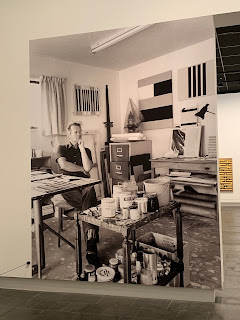 |
| The artist |
 |
| Tahi 1967 |
 |
| Tiki II 1966 |
 |
| Painting J 1974 |
 |
| Untitled 1989 |
 |
| Untitled (X) 1989 |
 |
| Notebooks |
 |
| Walters with some of his paintings |
Walters was working on the 1995 painting
Untitled Koru ( known as "The Last Koru") up to two weeks before his death in November 1995.
Walters had described his artistic work as "I want to say something very simple that keeps on working." It was a wonderful exhibit!
 |
| Untitled Koru 1995 |
We had time to spend a few minutes in the gift shop, which had wonderful displays of jewellery and other items. Very tempting, but we restrained ourselves.
 |
| View of gift shop |
 |
| Wonderful display of Māori pounamu and contemporary jewellery |
 |
| Interesting bookshelf displays |
 |
| Pendants with heads |
 |
| Gorgeous pins |
I wanted to be in a picture with the piano in front of the gallery.
We passed a few more Māori works with posters. Finally, there was a poster with the explanation of the project. They are "Woven Mats of Welcome" and are a series of 13 weaving patterns that feature within Te Papa Ōtākaro/Avon River Precinct. Each mat is an arrangement of natural stone pavers of varying shades and colours. In sequence they reference the process of welcome for all peoples visiting Christchurch and support the guiding principle of the rebuild: "Care for your people."
 |
| Putake Aronga |
As we walked back to the apartment, we passed the Empty Chairs installation. There were flowers on each chair, to commemorate the 8th anniversary of the earthquake.
 |
| The Empty Chairs with flowers |
We had a delicious salmon dinner (we had heard that Akaroa (very close to Christchurch) salmon was very good) and we were able to get some at the Farmers' Market. We also had fresh corn, zucchini, a green salad and half of our new bottle of Elephant Hill Sauvignon Blanc.



























































































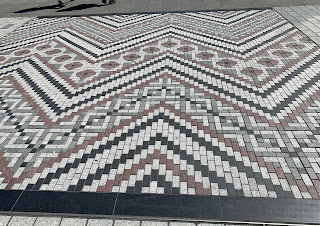










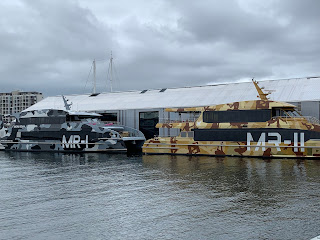
Comments
Post a Comment